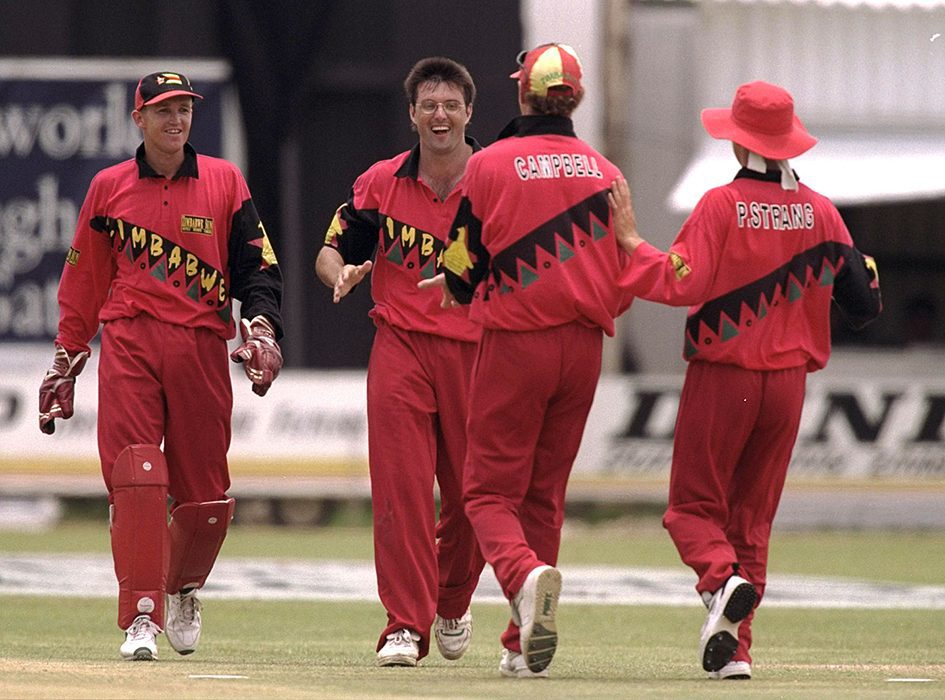33 years ago, Zimbabwe almost ended India’s World Cup dreams. Today, the team is a shadow of its old self. Binit Priyaranjan explores why.
On 18 June 1983, India and Zimbabwe met in the 20th game of the Prudential World Cup in the affluent Kentish town of Royal Tunbridge Wells, the only international match ever played at the ground. It was a clash of the two minnows in Group B—one team had won only one game, against East Africa, in the first two editions of the tournament, while the other, having achieved independence only three years before, was playing in its first World Cup. However, both teams had stunned the cricket world by beating the West Indies and Australia, respectively, in their first league games, and with three matches left to play in the group, were still in contention for the semi-finals.
After Zimbabwe captain and later India coach Duncan Fletcher lost his fifth consecutive toss in the tournament, though, Peter Rawson and Kevin Curran bowled the opening spell of their lives, extracting considerable seam and bounce off the track to scythe through India’s experienced top order. Once Yashpal Sharma had edged Rawson to wicket-keeper Dave Houghton, the score was 17 for 5 and India were staring at an ignominious defeat that would be disastrous for their net run rate and prospects of qualification. The rest, of course, is history—Kapil Dev would make full use of the small ground, questionable tactics by Fletcher and some sub-par performances by the supporting bowlers to score 175 not out in an innings of 266 for 8, which Sunil Gavaskar considers the best limited-overs innings he has ever witnessed; India would win by 31 runs and go on to beat Australia, England and the West Indies over the next week to win the Cup; and cricket in India would grow from a marginal presence to a religion. But on that chilly morning, Zimbabwe could have stopped history dead in its tracks.
Thirty three years later, as MS Dhoni’s ragtag bunch of youngsters completed India’s first overseas ODI whitewash under him with a comprehensive 10-wicket victory on Wednesday, there was hardly any applause, either in Harare or back home. The romping of Zimbabwe’s best by India’s newest has been a foregone conclusion from the start, with little competition or intrigue to offer. With the Copa América Centenario, the UEFA European Championship, India’s historic silver-medal run at the hockey Champions Trophy, and a much more fiercely competitive tri-series in the Carribean taking place at the same time, even the cricket-worshipping crowd of India has shown little interest in treating this victory as a festivity, owing to the performances of the Zimbabwean team over the last 12 months, which mark their worst-ever run in international cricket.
The rest, of course, is history—Kapil Dev would make full use of the small ground, questionable tactics by Fletcher and some sub-par performances by the supporting bowlers to score 175 not out in an innings of 266 for 8; India would win by 31 runs and go on to beat Australia, England and the West Indies over the next week to win the Cup; and cricket in India would grow from a marginal presence to a religion. But on that chilly morning, Zimbabwe could have stopped history dead in its tracks.
Zimbabwe posted two of their lowest totals ever against India—123 and 126—and India lost fewer wickets chasing down the runs than any team has ever lost in a three-match series. These stats alone speak volumes for the lopsidedness of the quality of cricket on display in Harare, and they represent the nosedive that Zimbabwean cricket has taken in the past decade, almost inverting Bangladesh’s rise in the same decade from virtually the same standing as Zimbabwe.
Fading Glory
After all, such a lacklustre away series against Zimbabwe despite such an inexperienced Indian squad would have been an unthinkable proposition just a decade ago. Douglas Marrilier’s miraculous innings in Faridabad, where he scooped a full-strength Indian team, came on 7 March 2002, the last in a series of fiercely competitive and exhilarating cricketing moments between the two sides, such as the victory at Leicester that effectively ended India’s hopes of winning the 1999 World Cup or Henry Olonga’s heroics at Sharjah in 1998. (Olonga’s celebrations after dismissing Tendulkar in that match earned him the Little Master’s ire in the final, where he scored 124 off 92 balls to lead India to a 10-wicket win with 20 overs to spare.)Zimbabwean teams in past generations have consisted of great players from all departments—world-class batsmen like the Flower brothers, Murray Goodwin and Alistair Campbell; all-rounders like Heath Streak and Fletcher; wicket-keeping batsmen like Houghton and Tatenda Taibu; quality quicks like Olonga and Eddo Brandes. A testament to Zimbabwe’s rich cricketing history is that in India’s inaugural tour of Zimbabwe in 1992, Zimbabwe made 456 in the first innings and almost made India follow on in its first ever Test match. They became the first ever team not to lose their first Test, and followed this strong opening performance with a golden age of sorts, beating full-strength teams from India, Pakistan, England and Australia over the next decade, including a Test series victory in Pakistan on the back of a stunning double-hundred by Grant Flower.
Douglas Marrilier’s miraculous innings in Faridabad, where he scooped a full-strength Indian team, came on 7 March 2002, the last in a series of fiercely competitive and exhilarating cricketing moments between the two sides, such as the victory at Leicester that effectively ended India’s hopes of winning the 1999 World Cup or Henry Olonga’s heroics at Sharjah in 1998.
In the 14 years since Marillier’s heroics, however, Zimbabwean cricket has found itself in its worst phase ever and looks a fading shadow of its past teams’ potential. It was the only full member team to not make it to the Super 10 at the World T20 this year, and are ranked even lower than Afghanistan in ODIs, to whom they’ve lost their last five T20s as well.
Causes of the Decline
The disintegration of Zimbabwean cricket over such a short time, described by Cricinfo’s Alagappan Muthu as cricket around the world surging forward “leaving Zimbabwe behind”, in a way, mirrors the fall of the cricketing might of Pakistan. The seeds of both these declines can be found in the political and economic circumstances of the country, from which sports and sporting facilities cannot remain disconnected.The most incisive and easy-to-spot consequence of the impact of the Zimbabwean political scenario on its cricket is the disappearance of white players from the team—both the Zimbabwe teams of the 1980s and ’90s, as well as the Rhodesia teams that played in South African domestic tournaments before independence, were almost exclusively white—but that is not in any way to suggest that the disappearance of the whites alone explains the loss in quality. This change in demographics is very much forced, with the mass migration of the white population of Zimbabwe under the regime of Robert Mugabe, who came to power based on his political struggle against the now-overthrown white minority rule in Zimbabwe. Mugabe implemented land reforms in 2000, which resulted in the seizing of 80 percent of white-owned farms, forcing thousands of evictions and arrests by 2002, among various reports of violence and human-rights violations.
Olonga and Andy Flower wore black armbands during their match at the Harare Sports Club to “mourn the death of democracy in Zimbabwe”, a gesture that generated as much praise as it did outrage and controversy in the home country.
It was in this political backdrop that Zimbabwean cricket’s moment of disintegration occurred in the 2003 World Cup, of which it was a co-host, in a match against Namibia. Olonga and Andy Flower wore black armbands during their match at the Harare Sports Club to “mourn the death of democracy in Zimbabwe”, a gesture that generated as much praise as it did outrage and controversy in the home country. Andy Flower thought the mix of one white and one black player lent balance to their message, which was widely lauded in international media and by fellow cricketers. Nasser Hussain, captain of England—who had forfeited their match against Zimbabwe in Harare due to security concerns—said the sportsmen “have proved to be great men by what they have done”, while The Times called it “a powerful blow for sanity, decency and democracy”.
The Zimbabwean government, cricketing board and even the public, however, had dangerously different reactions. Not only did Olonga play just one ODI following the protest, he was also charged with treason—punishable by death—and eventually forced out of Zimbabwe and international cricket, much like the Flowers shortly after. The protest thus represents a schism in Zimbabwean cricketing history, from which the team has never really recovered.
Bigger Patterns
The decline of Zimbabwe’s resources and economy under Mugabe hasn’t helped matters at all either. The aforementioned land reforms of the Mugabe government have failed, and in the process driven Zimbabwe into being one of the poorest and most lagging economies of the world.Cricketing facilities and interest have suffered immensely, as the dire conditions make sport a luxury the country can ill-afford to invest in or think about with any priority. The board is $19 million in debt and struggling to keep grounds open amidst a national water crisis.
In such circumstances, cricketing facilities and interest have suffered immensely, as the dire conditions make sport a luxury the country can ill-afford to invest in or think about with any priority. The board is $19 million in debt and struggling to keep grounds open amidst a national water crisis. Hence, the Zimbabwean team’s talent pool and training have depleted immensely, much like Pakistan’s receding economy and inability to host international teams has impacted the quality of cricket there, or the West Indies Cricket Board’s long-standing quarrel with its players has dented their cricketing glory, and inspired its own protests, like the cancelled Test series with India in 2014.
Also common is the fate of the sportspersons who participate in these protests, and that perhaps explains questions such as the ones asked in the “Sachin, unlike Ali” piece in The Indian Express. The board has for long had little tolerance for dissent, and hasn’t shied away from replacing senior cricketers demanding wage increases with younger, more pliable cricketers, such as in 2004, when 15 senior cricketers, including captain Heath Streak, were replaced by a second-string side led by 21-year-old Tatenda Taibu. The board, which has headed by Mugabe loyalist Peter Chingoka for 22 years, took this sort of backlash one step further with the action against Olonga and Flower, but the act of involving politics in sport has always been criticised and punished in every sporting association.
When the conflation of the two is almost always taken as a sign of indiscipline and dissent, is it a surprise that most sporting personalities stay silent? It is true Ali paid for his beliefs with his title amongst much else, but it can be argued that he had the unconditional backing of an entire community that he and his message directly represented. When conditions are not so favourable for taking a political stance, however, the sportsman remains tentative with his beliefs.


